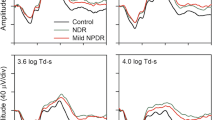Abstract
The International Society for Clinical Electrophysiology of Vision (ISCEV) protocol for eliciting oscillatory potentials uses a considerably lower flash intensity and a different preconditioning stimulus than the only oscillatory potential protocol used to predict progression of diabetic retinopathy. To determine if the ISCEV protocol will be useful in predicting progression of diabetic retinopathy, summed oscillatory potential amplitudes were measured by both protocols in a population of diabetics. Summed oscillatory potential amplitudes measured by the ISCEV protocol, although smaller, are highly correlated with the summed oscillatory potential amplitudes measured with the higher-intensity flash. Thus, summed oscillatory potential amplitudes measured with the ISCEV protocol should be useful in predicting outcome in diabetic retinopathy. Different signal processing filters used to extract oscillatory potentials from the electroretinogram waveform have a small, but significant, effect on summed oscillatory potential amplitude. Use of the caliper-square method or the summed peak-to-trough method for measuring oscillatory potential heights had an insignificant effect on measured oscillatory potential amplitude.
Similar content being viewed by others
Abbreviations
- FIR:
-
finite impulse response
References
Cobb WA, Morton HB. A new component of the human electroretinogram. J Physiol 1954; 123: 36P-7P.
Speros P, Price J. Oscillatory potentials: History, techniques, and potential use in the evaluation of disturbances of retinal circulation. Surv Ophthalmol 1981; 25: 237–52.
Ogden TE. The oscillatory waves of the primate electroretinogram. Vision Res 1973; 13: 1059–73.
Yonemura D, Aoki T, Tsuzuki K. Electroretinogram in diabetic retinopathy. Arch Ophthalmol 1962; 68: 19–24.
Simonsen SE. Prognostic value of ERG (oscillatory potential) in juvenile diabetics. Acta Ophthalmol 1975; 123 (suppl): 223–4.
Bresnick GH, Korth K, Groo A, et al. Electroretinographic oscillatory potentials predict progression of diabetic retinopathy. Arch Ophthalmol 1984; 102: 1307–11.
Bresnick GH, Palta M. Predicting progression to severe proliferative diabetic retinopathy. Arch Ophthalmol 1987; 105: 810–4.
Bresnick GH, Palta M. Oscillatory potential amplitudes: Relation to severity of diabetic retinopathy. Arch Ophthalmol 1987; 105: 929–33.
Marmor MF, Arden GB, Nilsson S-EG, Zrenner E. Standard for clinical electroretinography. Arch Ophthalmol 1989; 107: 816–19. Reprinted in Doc Ophthalmol 1989; 73 (4): 303–311.
Wachtmeister L. Oscillatory potential recording. In: Heckenlively JR, Arden GB, eds. Principles and practice of clinical electrophysiology of vision. St Louis, MI: Mosby Year-Book, 1991: 322–7.
Massof R, Drum B, Breton M. Ophthalmic electrophysiology with a microcomputer-based system. In: Mize RR ed. The microcomputer in cell and neurobiology research. New York: Elsevier, 1985: 448–66.
The Diabetic Retinopathy Study Research Group. A modification of the Airlie House classification of diabetic retinopathy. Invest Ophthalmol Vis Sci 1981; 21: 210–26.
Ghausi MS, Laker JR. Modern filter design. Englewood Cliffs, NY: Prentice Hall, 1981: 389–98.
Algevere P, Wachtmeister L. On the oscillatory potentials of the human electroretinogram in light and dark adaptation, II: Effect of adaptation to background light and subsequent recovery in the dark. A Fourier analysis. Acta Ophthalmol (Copenh) 1972; 50: 837–63.
Author information
Authors and Affiliations
Rights and permissions
About this article
Cite this article
Severns, M.L., Johnson, M.A. & Bresnick, G.H. Methodologic dependence of electroretinogram oscillatory potential amplitudes. Doc Ophthalmol 86, 23–31 (1994). https://doi.org/10.1007/BF01224625
Accepted:
Issue Date:
DOI: https://doi.org/10.1007/BF01224625




